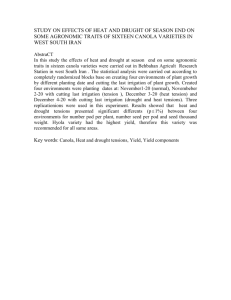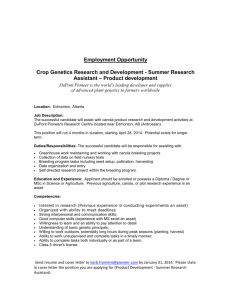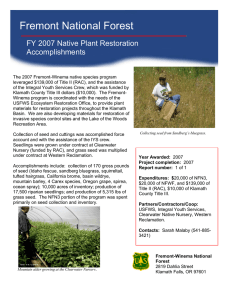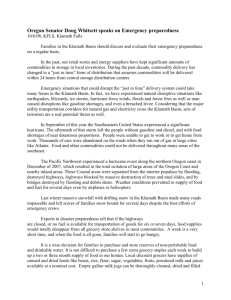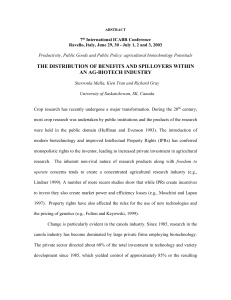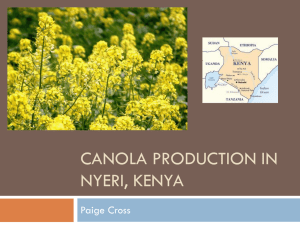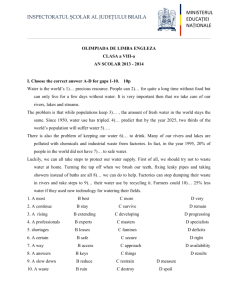Growth, Yield, and Oil Production of Canola Varieties in
advertisement
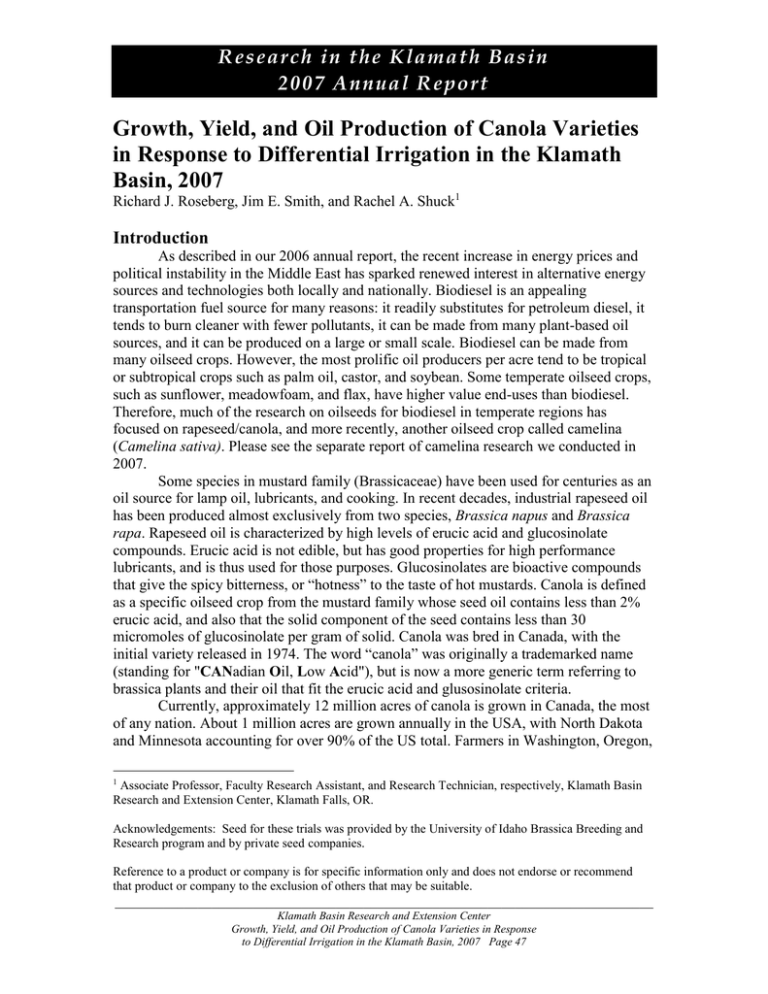
Research in the Klamath Basin 20 07 Annual Report Growth, Yield, and Oil Production of Canola Varieties in Response to Differential Irrigation in the Klamath Basin, 2007 Richard J. Roseberg, Jim E. Smith, and Rachel A. Shuck1 Introduction As described in our 2006 annual report, the recent increase in energy prices and political instability in the Middle East has sparked renewed interest in alternative energy sources and technologies both locally and nationally. Biodiesel is an appealing transportation fuel source for many reasons: it readily substitutes for petroleum diesel, it tends to burn cleaner with fewer pollutants, it can be made from many plant-based oil sources, and it can be produced on a large or small scale. Biodiesel can be made from many oilseed crops. However, the most prolific oil producers per acre tend to be tropical or subtropical crops such as palm oil, castor, and soybean. Some temperate oilseed crops, such as sunflower, meadowfoam, and flax, have higher value end-uses than biodiesel. Therefore, much of the research on oilseeds for biodiesel in temperate regions has focused on rapeseed/canola, and more recently, another oilseed crop called camelina (Camelina sativa). Please see the separate report of camelina research we conducted in 2007. Some species in mustard family (Brassicaceae) have been used for centuries as an oil source for lamp oil, lubricants, and cooking. In recent decades, industrial rapeseed oil has been produced almost exclusively from two species, Brassica napus and Brassica rapa. Rapeseed oil is characterized by high levels of erucic acid and glucosinolate compounds. Erucic acid is not edible, but has good properties for high performance lubricants, and is thus used for those purposes. Glucosinolates are bioactive compounds that give the spicy bitterness, or “hotness” to the taste of hot mustards. Canola is defined as a specific oilseed crop from the mustard family whose seed oil contains less than 2% erucic acid, and also that the solid component of the seed contains less than 30 micromoles of glucosinolate per gram of solid. Canola was bred in Canada, with the initial variety released in 1974. The word “canola” was originally a trademarked name (standing for "CANadian Oil, Low Acid"), but is now a more generic term referring to brassica plants and their oil that fit the erucic acid and glusosinolate criteria. Currently, approximately 12 million acres of canola is grown in Canada, the most of any nation. About 1 million acres are grown annually in the USA, with North Dakota and Minnesota accounting for over 90% of the US total. Farmers in Washington, Oregon, 1 Associate Professor, Faculty Research Assistant, and Research Technician, respectively, Klamath Basin Research and Extension Center, Klamath Falls, OR. Acknowledgements: Seed for these trials was provided by the University of Idaho Brassica Breeding and Research program and by private seed companies. Reference to a product or company is for specific information only and does not endorse or recommend that product or company to the exclusion of others that may be suitable. ______________________________________________________________________________ Klamath Basin Research and Extension Center Growth, Yield, and Oil Production of Canola Varieties in Response to Differential Irrigation in the Klamath Basin, 2007 Page 47 Research in the Klamath Basin 20 07 Annual Report and Idaho grow several thousand acres in each state per year. With the recent increase in energy prices, canola has been tested and grown on a smaller scale in many regions of the country. Research Justification & Objectives We found no evidence of oilseed-to-biodiesel research or commercialization efforts in the arid south central Oregon plateau, including the Klamath Basin, prior to 2005. Much of this region has irrigation water available, and oilseed crops that are suited to a cooler climate such as canola, industrial rapeseed, mustards (Sinapsis alba and Brassica juncea), and camelina seemed to have a possible fit with existing crops such as potatoes, grass and alfalfa hay, and small grains. In 2006 we began evaluating canola and related species. In 2007 we continued our evaluation of canola and related brassicas. The objective of this study was to measure the growth, seed yield, and oil yield of several public and private varieties of spring-planted canola grown under two levels of irrigation to determine the general effect of reduced moisture availability as well as to determine if certain varieties were more tolerant of moisture stress. Procedures The canola variety and irrigation rate trials were conducted at the KBREC research farm on the mineral soil type (Poe fine sandy loam), on land that had been planted to spring wheat in 2006. Within each irrigation rate block, the 19 entries were planted in a randomized complete block design with four replications. Entries included both named varieties and numbered experimental lines. Entries included seven conventional canolas, seven Roundup®-Ready canolas, one Clearfield® non-GMO canola, two yellow mustards, and two industrial rapeseeds. Seed was planted at 0.5 inch depth. Seeding rates were based on recommendations of researchers at the University of Idaho and private company professionals, and were as follows: Pacific Gold yellow mustard was seeded at the rate 5.0 lb/ac; Gem rapeseed and Clearwater canola were seeded at 7.0 lb/ac, while Idagold yellow mustard, Sterling rapeseed, and all remaining canola entries were seeded at 8.0 lb/ac. All entries were seeded with a Kincaid (Kincaid Equipment Manufacturing) plot planter on May 1. The plots were 20 by 4.5 ft, (9 rows at 6-inch spacing), with a harvested area of 14.5 by 4.5 ft. Trifluralin (Treflan®) herbicide was applied April 27 at 2.0 pint/ac (1.0 lb a.i./ac) pre-plant incorporated with roto-tiller. No additional herbicides were applied during the season. All plots were fertilized with 12 lb/acre N, 12 lb/acre P2O5, 12 lb/ac K2O, and 15 lb/acre S banded at planting (applying 12-12-12-15 fertilizer at 100 lb/acre). An additional 100 lb/acre N was applied as Solution 32 on June 4 through the irrigation water. Solid-set sprinklers arranged in a 40- by 40-ft pattern were used for irrigation. The entire area was irrigated uniformly until plants were fully emerged. Crop water use estimates from the KBREC Agricultural Meteorological (AgriMet) weather station were then used to apply irrigation at a rate to meet crop needs for the full growing season in the “wet” irrigation block. The “dry” irrigation block received about 5/8 the amount of ______________________________________________________________________________ Klamath Basin Research and Extension Center Growth, Yield, and Oil Production of Canola Varieties in Response to Differential Irrigation in the Klamath Basin, 2007 Page 48 Research in the Klamath Basin 20 07 Annual Report irrigation applied to the “wet” block after the initial germination period. Precipitation and irrigation details are shown in Table 1. Plots were swathed with a Swift Mfg. plot swather on August 17 when approximately 1/3 to 2/3 (varying depending on variety) of the seeds had turned brown. Seed was harvested from all plots using a Hege (Hans-Ulrich Hege) plot combine with a 4.5-ft-wide header on August 23. Data collected included lodging percent, grain yield, test weight, and plant height. Cleaned seed samples were sent to the Brassica Breeding and Research Lab (Dr. Jack Brown) at the University of Idaho for seed oil analysis. All measured parameters were analyzed statistically using SAS® for Windows, Release 9.1 (SAS Institute, Inc.) software. Treatment significance was based on the F test at the P=0.05 level. If this analysis indicated significant treatment effects, least significant difference (LSD) values were calculated based on the student’s t test at the 5 percent level. Results and Discussion Soil moisture was good during seedbed preparation, and resulting germination and stand density were good. Weed pressure was light and did not seem to impact crop growth. Good availability of irrigation water, lack of frost, and relatively few hot days during the season (only eight days with maximum temperatures above 90oF, with none over 100oF), all contributed to good yields in 2007. The higher rate of N fertilizer applied after emergence in 2007 probably contributed to generally higher yields in 2007 compared to 2006. Harvest occurred later in 2007 compared to 2006 due to slightly later planting date and observed slower rate of maturation. Lodging was minimal in all trials. There were significant differences between entries for all five measured parameters for both irrigation regimes (Tables 2&3). Wet Treatment Area Within the wet block, seed yield ranged from 1590 to 3760 lb/ac, with a mean of 2590 lb/ac. This trial mean was greater than the trial mean of 1880 lb/ac in 2006 grown under similar management (except less N fertilizer was applied in 2006). In the 2007 trial, the experimental numbered canolas all were among the highest-yielding entries, and the Roundup®-Ready trait did not seem to result in a particular yield advantage or disadvantage. As in 2006, the seed yield of Idagold mustard was close to the overall trial mean, whereas Pacific Gold mustard had the lowest seed yield in 2007 (and was among the lowest in 2006). As in 2006, Idagold yellow mustard had the highest bushel weight in 2007. In 2006, many of the entries with high yield also had high bushel weight, but this trend was not as clear in 2007. See the KBREC 2006 annual report to make further comparisons between years. The 2007 entries tended to be taller than their 2006 counterparts, and the overall trial mean was nearly 9 inches taller in 2007. The percent flowering data was not collected in 2007, but visually it was clear that the two yellow mustards clearly reached maturity sooner than the canolas and rapeseed, although there was quite a range in maturity amongst the canola types. In this climate where the length of growing season is limited, an early-maturing variety could be an advantage if yield is not limiting. ______________________________________________________________________________ Klamath Basin Research and Extension Center Growth, Yield, and Oil Production of Canola Varieties in Response to Differential Irrigation in the Klamath Basin, 2007 Page 49 Research in the Klamath Basin 20 07 Annual Report Seed oil content varied among entries, but in most cases these differences were not enough to dramatically alter the ultimate oil yield ranking. Thus in most cases oil yield was mainly determined by seed yield, not seed oil content. One exception was Idagold yellow mustard, which ranked 9th in seed yield, but only 18th in oil yield due to its very low seed oil content. Dry Treatment Area There were significant differences between entries for all five parameters. Other than MB52142, the experimental canolas did not have as high a relative seed yield as they had in the wet treatment zone. The two rapeseed entries did not perform well in the dry treatment block. As in the wet block, IdaGold had the highest bushel weight in the dry block, and also was the tallest entry. Despite the variation observed for seed oil content, oil yield generally followed the ranking for seed yield. Again, the main exception to this pattern was Idagold mustard, whose low seed oil content reduced its oil yield ranking compared to the other entries, although this effect was not as pronounced in the dry block as it had been in the wet. Overall, the seed yield and bushel weight were only slightly reduced in the dry block compared to the wet block, but height and seed oil content both appeared to be reduced in the dry block where moisture was more limiting. The entries did not necessarily perform the same relative to each other in the wet and dry treatment areas. MB52142 and to a lesser degree Hyclass905, Hyola 401, and Hyclass 910 produced high seed yields in both moisture regimes. Pacific Gold, Sterling, Gem, Premier produced low seed yields in both moisture environments. Some entries responded to additional irrigation, producing higher relative and absolute seed yields in the wet treatment area (Hyclass 910, MB52140, MB52155, and V2018). In a few cases an entry produced higher absolute seed yield under reduced irrigation (Python, IS 7145 RR, and to a lesser degree 1852H and Hyclass 905). Summary To our knowledge, 2006 was the first year canola varieties and related species had been evaluated in an organized way for yield in the Klamath Basin. Agronomic management improved in 2007, resulting in increased seed yields overall. Reducing irrigation seemed to have a greater effect on plant height and seed oil content than it did on seed yield, oil yield, and bushel weight, although all parameters tended to be lower under reduced irrigation. However, the entries did not respond equally to reduced irrigation, and some entries had a greater relative and absolute seed yield in the dry block where they experienced greater moisture stress. In situations of limited or sporadic irrigation water availability, such varieties could provide a beneficial management option for growers wishing to produce seed oil in this region. Depending on canola’s fit into existing crop rotations, oilseed brassicas seem to have good potential to provide marketable quantities of oil for biodiesel or other uses in the Klamath Basin. ______________________________________________________________________________ Klamath Basin Research and Extension Center Growth, Yield, and Oil Production of Canola Varieties in Response to Differential Irrigation in the Klamath Basin, 2007 Page 50 Research in the Klamath Basin 20 07 Annual Report Commercial Activity & Future Prospects Canola was planted on approximately 500 acres by local growers in 2007. A few acres were planted in fall 2006, but the vast majority of these plantings were made in the spring. The fall plantings seemed to survive and produce moderate seed yields (approx. 2000 lb/ac) if they had sufficient moisture during cold spring weather, otherwise their survival and yield suffered. The reported yield of commercial spring plantings varied from about 1030 lb/ac to 3700 lb/ac (Rick Walsh, pers. Comm., 2007). The highest yields were in fields that were planted early (late April). However, most of the early planted fields also suffered from an unusually cold spring where daily low temperatures were in the mid-20s (oF) for six days in late April and early May. Temperatures tended to be lower, and damage worse, on the high organic matter lower lake soils compared to the upland mineral soils, but damage seemed to be reduced if soils were sufficiently moist at the surface. Most fields planted in mid to late May produced yields in the 2000-2400 lb/ac range, while some later June plantings suffered from heat and insufficient irrigation water during pollination and seed filling, resulting in reduced yields of about 1200 lb/ac. A commercial biodiesel production facility is currently in operation south of Klamath Falls, and a Willamette Valley-based company has been scouting for contracts in this area, but high grain prices have led most growers to plant wheat and barley instead of the more speculative canola or other oilseed crops such as camelina. The future economics of diesel fuel and small grains will likely dictate the future interest in, and commercial production of, canola for biodiesel in the Klamath Basin. A relatively small ongoing level of research into oilseed crops should allow rapid adoption and commercialization of these crops when economic conditions warrant their widespread production. ______________________________________________________________________________ Klamath Basin Research and Extension Center Growth, Yield, and Oil Production of Canola Varieties in Response to Differential Irrigation in the Klamath Basin, 2007 Page 51 Research in the Klamath Basin 20 07 Annual Report Table 1. 2007 Precipitation and irrigation for canola variety x irrigation rate trails. Klamath Basin Research and Extension Center, Klamath Falls, OR. Month Precipitation (inch) Wet Block Irrigation (inch) Irrigation Applications Dry Block Irrigation (inch) Irrigation Applications April May June July August 0.73 0.24 0.44 0.57 0.18 0.00 3.78 5.74 7.14 3.08 0 7 6 9 3 0.00 3.78 3.01 4.62 2.24 0 7 3 6 2 Total 2.16 19.74 25 13.65 18 ______________________________________________________________________________ Klamath Basin Research and Extension Center Growth, Yield, and Oil Production of Canola Varieties in Response to Differential Irrigation in the Klamath Basin, 2007 Page 52 Research in the Klamath Basin 20 07 Annual Report Table 2. 2007 Canola variety trial under full irrigation, planted in mineral soil (ranked by seed yield). Klamath Basin Research and Extension Center, Klamath Falls, OR. Seed Variety Type Seed Yield (lb/ac) Hyclass 910 MB 52142 MB 52140 MB 52155 Hyola 401 IS 7145 RR Hyclass 905 V2018 IdaGold Clearwater 1852H Hyola 357 Magnum DKL52-41 Sterling Python Gem IS 3057 RR Premier PacificGold RR Canola Exp Canola Exp Canola Exp Canola Conv Canola RR Canola RR Canola Conv Canola Mustard Conv Canola RR Canola Conv Canola RR Canola Rapeseed Clearfield Canola Rapeseed RR Canola Conv Canola Mustard 3760 3420 3000 2950 2900 2760 2760 2710 2640 2620 2560 2430 2410 2400 2310 2290 2200 2180 1590 Mean LSD (0.05) CV (%) P value 2590 680 18.2 <0.001 Rank BuWt (lb/bu) 1 2 3 4 5 6 6 8 9 10 11 12 13 14 15 16 17 18 19 48.1 51.3 50.1 50.9 50.7 50.9 49.7 48.5 55.0 50.7 51.1 49.5 50.8 49.8 49.0 50.7 50.5 50.9 50.0 50.5 1.3 1.8 <0.001 Height Rank (inch) 19 2 12 4 10 5 15 18 1 8 3 16 7 14 17 9 11 6 13 57.8 46.0 49.5 50.5 47.3 50.0 61.0 56.3 48.0 50.0 51.0 45.8 46.8 43.0 53.8 46.0 43.5 48.8 53.8 49.6 7.4 10.5 <0.001 Oil Content Rank (%) Rank 2 15 10 7 13 8 1 3 12 8 6 17 14 19 4 15 18 11 4 40.1 42.6 41.3 40.6 40.1 41.8 40.8 41.2 28.1 40.6 40.5 38.6 41.1 39.9 39.3 40.8 41.2 40.7 36.1 39.7 1.4 2.5 <0.001 13 1 3 11 13 2 8 5 19 10 12 17 6 15 16 7 4 9 18 Oil Yield (lb/ac) Rank 1510 1460 1240 1200 1160 1150 1120 1110 740 1060 1040 940 990 960 910 930 910 890 570 1 2 3 4 5 6 7 8 18 9 10 13 11 12 15 14 16 17 19 1050 280 18.5 <0.001 ______________________________________________________________________________ Klamath Basin Research and Extension Center Growth, Yield, and Oil Production of Canola Varieties in Response to Differential Irrigation in the Klamath Basin, 2007 Page 53 Research in the Klamath Basin 20 07 Annual Report Table 3. 2007 Canola variety trial under reduced irrigation, planted in mineral soil (ranked by seed yield). Klamath Basin Research and Extension Center, Klamath Falls, OR. Seed Oil Content Rank (%) Rank Variety Type Seed Yield (lb/ac) IS 7145 RR RR Canola 3390 1 51.3 3 39.3 7 41.0 1 1390 1 MB 52142 Python Hyclass 905 1852H Hyola 401 Hyclass 910 MB 52140 MB 52155 DKL52-41 Clearwater IdaGold V2018 IS 3057 RR Hyola 357 Magnum PacificGold Premier Gem Sterling Exp Canola Clearfield Canola RR Canola RR Canola Conv Canola RR Canola Exp Canola Exp Canola RR Canola Conv Canola Mustard Conv Canola RR Canola Conv Canola Mustard Conv Canola Rapeseed Rapeseed 3040 3040 2970 2800 2750 2680 2660 2500 2490 2470 2390 2080 2060 2030 1960 1940 1780 1660 2 2 4 5 6 7 8 9 10 11 12 13 14 15 16 17 18 19 50.7 49.4 49.0 50.8 50.3 47.5 52.2 50.8 50.0 50.0 55.1 49.4 50.6 48.9 49.4 50.1 49.7 48.7 6 14 16 5 8 19 2 4 10 11 1 15 7 17 13 9 12 18 32.3 45.0 39.3 35.3 32.5 47.3 38.3 34.0 35.5 39.8 47.5 40.0 33.5 30.0 40.0 33.8 30.5 29.5 16 3 7 11 15 2 9 12 10 6 1 4 14 18 4 13 17 19 40.4 38.3 39.6 38.2 37.4 38.2 35.2 37.3 39.2 38.3 26.0 39.0 39.5 36.7 36.7 38.6 38.2 37.4 2 8 3 12 14 10 18 15 5 9 19 6 4 16 17 7 10 13 1230 1170 1180 1070 1030 1030 940 930 980 950 620 810 810 750 720 750 680 620 2 4 3 5 7 6 10 11 8 9 18 13 12 15 16 14 17 19 Mean LSD(0.05) CV (%) P value 2460 650 18.8 <0.001 Rank BuWt (lb/bu) 50.2 1.4 2.0 <0.001 Height Rank (inch) 37.0 5.5 10.5 <0.001 37.6 1.5 2.8 <0.001 Oil Yield (lb/ac) Rank 930 260 20.0 <0.001 ______________________________________________________________________________ Klamath Basin Research and Extension Center Growth, Yield, and Oil Production of Canola Varieties in Response to Differential Irrigation in the Klamath Basin, 2007 Page 54
